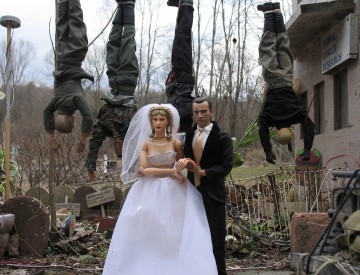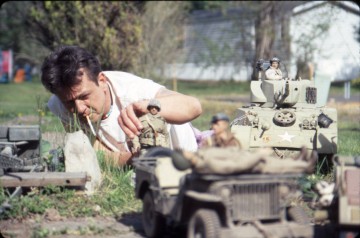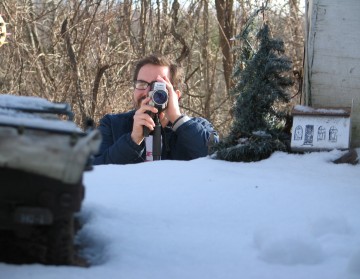Sadly, this is Nick’s last post for the foreseeable future. At least we know he’s not able to contribute for good reasons. Season 6 production has started to seriously heat up, and I know he’s also very actively engaged in pre-production for a brand new, not yet publicly announced Art21 web video series. He hopes to return to regular posting when work (and life) calms down. — Ed.
Yes, unhappily, it’s my last posting. But happily, I think it’s going to be of interest to a lot of folks — an interview with director Jeff Malmberg, the filmmaker behind Marwencol, the 2010 South by Southwest Film Festival Grand Jury award winner for best documentary. Marwencol is a pretty remarkable blend of profile, first person confession, and art documentary. Here’s the basic story, in the words of the Marwencol website:
Marwencol is a documentary about the fantasy world of Mark Hogancamp. After being beaten into a brain-damaging coma by five men outside a bar, Mark builds a 1/6th scale World War II-era town in his backyard. Mark populates the town he dubs “Marwencol” with dolls representing his friends and family and creates life-like photographs detailing the town’s many relationships and dramas. Playing in the town and photographing the action helps Mark to recover his hand-eye coordination and deal with the psychic wounds of the attack. When Mark and his photographs are discovered, a prestigious New York gallery sets up an art show. Suddenly Mark’s homemade therapy is deemed “art”, forcing him to choose between the safety of his fantasy life in Marwencol and the real world that he’s avoided since the attack.
There’s a lot stuff already out on there on the film and director Jeff (collected on the Marwencol site) so I thought I’d take the opportunity to ask some intentionally non-context setting, but hopefully thought-provoking questions, while still hitting all my little Art21 pet obsessions. But before we start, I should mention a couple of ways you can experience the film and art in person. The Esopus Gallery in New York will be showing Mark’s original photos of Marwencol thru October 28. And even better, the film has just started its gradual national release; it’s currently at the IFC Center in New York, and will open in a lot of other big cities in November and December.
Nick Ravich: Thanks for the time, Jeff. Marwencol is really your first directing effort — but your background is in editing.
Jeff Malmberg: That’s why I ended up getting the bug and wanting to try “directing” is because I edited a documentary a couple years ago and had so much fun with it, and I thought, wow, there’s just so many directions you can head. You know, it was almost like you were writing with footage, and trying to create this portrait out of these hundreds of hours of footage that you had. And so once I finished that up, it was called Red, White, Black, and Blue, and it played on PBS in 2007. I thought, maybe I should try my hand at directing, not realizing of course that what I was really signing up for was the ultimate editing exercise. The directing in this case was really just going out and trying to get to know someone and just mowing down as much footage as I could so that I could come back in the edit room and really live with it for a long time and see what came out. So the directing was really a wonderful experience, but the film was made in the edit room. And it was such a deep and rich subject that just kept getting deeper the more I’d talk to Mark. And I knew that if I just shot…as much as I could, I could edit my way out of it.
NR: I’m guessing you were probably thinking like an editor when you were shooting.
JM: Yeah, although it was funny, I realized in my B-roll I was thinking too much like an editor . . . usually a cameraman will give you a rack in, rack out. And they’ll give you all the options. And there’ll be fifteen seconds when you only need three and a half or whatever. And I was editing in camera so I would literally have the exact number of frames that I needed and no more sometimes. So that was a lesson for me.
NR: I know a lot of folks have compared Marwencol to Errol Morris’s films. I’m curious if there are any other, maybe less obvious influences?
JM: You know, when I worked on it, I tried very consciously to not watch docs, which was hard because it’s three-four years. But I do know that there were some films that I wanted to watch just as touchstones before I started cutting to see how they dealt with the subjects. [One] was Marjoe, that amazing documentary.
NR: I don’t know that one.
JM: Oh it’s so good, you got to check it out, it’s just amazing. I think [it was made in] ’72, about a revival preacher in the south who was [preaching] ever since he was five years old and forced into it by this parents. And that’s why his name is Marjoe, it’s a combination of Mary and Joseph. And you know by the time we meet him in the documentary, it’s the ‘60s, or it’s the early ‘70s and he’s a teenager questioning his values. And it’s a film of somebody at a crossroads. Cause I felt like every time I dealt with Mark and every time I talked to him he was at a crossroads. Rivers and Tides . . . I just always thought that was a beautiful delivery of someone’s interior world. And I always imagined the film being very quiet and not having any other voices in it besides Mark’s, but that didn’t end up being the case . . . Meeting People Is Easy, that Radiohead documentary . . . I think also because Mark’s a big Radiohead fan and I had given him a copy of that film just as a friend and he [asked], “hey do you think my documentary will be like that?” But I think there’s a lot of textures in that. And I think that it’s very experiential; the plot kind of flows.
NR: Let’s talk about the structure of the film. How did you map it out?
JM: Well I purposely never did a paper cut because I always feel like you lose some of the joy and flavor when you paper cut a scene . . . let’s say you’re doing the scene about Mark’s relationship to women in his second life [after the assault]. You’re going to go through your transcripts and you’re going to pull out five bites and it’s going to go to A to B to C to D to E. And it will have enough structure and you can move on, but you’ve never really had a chance to explore how you feel about that, how Mark really feels about it. . . And I think it’s probably why it took so long to cut is that I just was not going to do a paper cut. It was all a function of note cards. I had two giant, you know those Staples pen boards and this notecard system with dots and all this stuff to try and keep some order over the footage, cause I had a ton. So in terms of trying to find the narrative thread of it, I mean of course the art show has created this narrative thread and I had shot so much during that time that that really became the core structure of this person going on this trip and we’re going on a trip with him . . . It was interesting, any time I tried to vary that and pump it up unrealistically from how the experience was, it just rang false. So it really became a mantra in the edit room of “have the audience be able to experience it the same way you experienced Mark.” Of course that’s not always going to be true, because I showed up and Mark talked about “X,” whereas I’m not going to start with that. But as a core engine, I really wanted it to be a document of my trip, getting to know Mark. Luckily, Mark had enough twists and turns and every time I would talk to Mark there would be some new element that messed with my thinking about everything else.
NR: One of the things that really struck me about Mark as an artist is his relationship to the photographs he takes of Marwencol. They’re obviously very intentionally composed but in the end, it’s almost like they’re a kind of personal documentation, like vacation photos. What’s Mark’s view of them?
JM: You’re heading up a very interesting area. I think initially for him they functioned as memories. He’s a very emotional person and he was so lacking in memories of his life that the way he used to talk about those photos when I first met him was that they were snapshots to a new life . . . And you know nothing makes Mark sadder than not being able to remember his past or how close he was to his mother and his first wife or things like that . . . [The photos] have beauty in them and they’re composed brilliantly, but he’s really composing them to illicit emotion in himself. And now it’s become something where he doesn’t mind if other people share in that. I mean he takes some pride in that as an artist.
NR: Does he revisit the photos?
JM: I don’t think so. He’d just keep them under the bed. I mean he’d throw away the negs. I’ve searched through that box with him, which is just great . . . It didn’t make the film, but he’ll literally [say], “oh this is the first photo I ever took.” This is the S.S. coming to attack me. You can see the progression of learning that a certain light is good and learning that he needs to get down at the level of the characters and learning what angles work and what distance from the subject works and things like that. So it’s interesting to see the progression of that, now that he has it down cold. He couldn’t do a poor-looking photo if he tried now.
NR: And it seems like his photos freed you up from the burden of taking your own beauty shots of Marwencol. I really appreciated how there weren’t any long, choreographed, obviously expensive tracking shots.
JM: Thank you. It’s interesting to know, having been through this process, which things are intentional and which aren’t. I think it just comes down to what feels right, because that shoot that you’re talking about of the town was very early in my mind. I even tried some of it on my first trip. It just didn’t really have any resonance and I think the reason is because it wasn’t coming from Mark’s point of view . . . The interesting lesson for me is that it works well without it. I think that we’re so used to being told a story in a certain kind of way now, in a big budget way . . . I think people take it into their heart more when you’re not pulling tricks. [It] was a big thing for me to never move on Mark’s photos at all. I think I moved on one photo once.
NR: As the Director of Production for Art21, and someone directly responsible for producing the moves on our reproductions, that’s outright blasphemy.
JM: It almost comes from this place of fear, like, how can I wow ‘em? What you find at the end of the day is that you’re just a frame. He’s the subject. And you have to be true to that. You don’t need to one-up somebody so interesting. You only need to frame them.
NR: Another thing that really struck me about Mark is his relentless storytelling. It almost seems effortless. Does Mark rehearse the doll narratives before photographing them?
JM: No. I’ve seen him do it and you see a little bit of it in the movie when he’s about to go to the waterfall and he’s trying to decide who to bring. He’ll talk to himself and sort of to me, out loud when I’m there, about “well, this could happen or this could happen” . . . And the times I’ve seen it, you can hear him or see him get the idea and then he rushes off while it’s still fresh in his mind and just nails all his photos. So I think that as important as the photo-taking is, it’s that life of the mind all day long of what’s happening to these various characters and who’s saying what. It’s expanded now — his relationship with Marwencol runs so deep he’ll talk about how characters will talk to him between photo shoots. Seriously, and talk to him at night . . . That waterfall scene is, was probably my favorite day shooting because I really got to see an artist at work and I really got to observe him as he came around to forming an idea and photographing it.
NR: The ethical relationship between a documentary director and their subject always fascinates me. Mark is in many ways a very vulnerable figure.
JM: That was definitely front and center in my mind at all times. And it’s a tough one. But when you get down to it, it’s really easy . . . There are a lot of different ways you could head with the material that I had, but I felt like Mark was telling me as a friend and not as public consumption. Because you get to the point where you do forget the camera’s [on.] And amazing things can happen. But it’s up to you to be the ethical judge of what is usable and what is not usable and…shouldn’t be used. Some of the times where it was the most heartbreaking, I couldn’t turn on the camera . . . I think it’s easy when you’re doing it about a subject you care about. I think it would be more difficult to do a subject that you didn’t like. Frankly if I didn’t like Mark as a person, I would have made a short film and I would have left. But here’s somebody who is so kind and wonderful and interesting and quixotic and strange and I just love him to death. So I wanted to learn more about him and simultaneously I wanted to shape a film where the audience could fall in love with someone’s point of view as well as his artwork and things like that. So as long as you come at it from that point of view, you can’t really falter because you’re doing it out of kindness.








